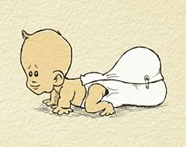The dirt on diapers
Ann Douglas


Diaper facts and trivia
You can expect to change your baby’s diaper approximately 4700 times before he is fully trained. Here’s some fun diaper-related trivia to ponder while you’re making all those trips to the changing table!
- 1. In other societies, natural materials were used to make diaper-like coverings: grass was packed under a diaper cover made of rabbit skin or moss was tucked inside a cover made of sealskin.
- 2. A typical newborn urinates 20 to 30 times each day. Luckily, you don’t have to change the baby’s diaper quite that often: in most cases, every couple of hours will do.
- 3. Think it takes a lot of time to diaper and change your baby today? Imagine what it must have been like for seventeenth century moms. Deborah Jackson describes diapering practices in this bygone era in her book With Child: Wisdom and Traditions for Pregnancy, Birth, and Motherhood (Chronicle Books, 1999): “A seventeenth-century swaddled baby wore a linen shirt; a long bellyband for stomach support; a fine diaper or nappy square; a large rectangular wrap or ‘bed’ to hold his arms against his sides; swaddling bands; another ‘bed'; and finally a ‘stayband’ to keep his head straight. This textile parcel was topped off with two linen caps and a triangular decoration known as a ‘biggin.’ The result was a generation of babies who were passive and immobilized.”
- 4. During the seventeenth century, it was widely believed that urine had disinfecting qualities. Rather than washing their babies’ urine-soaked diapers, mothers simply lay them to dry in front of the fire. And instead of washing their babies’ bottoms at diaper-changing time, they simply powdered them with the dust of worm-eaten wood – the baby powder of generations gone by.
- 5. Parents of the 1940’s were encouraged to start toilet training shortly after birth. Consider this advice from one of the bestselling parenting advice books of the era: “If properly trained, it is surprising how easily a child may be made to acquire clean habits. Usually a child, when a month old, will go to stool at a definite time of the day, or it may be trained to this by the use of soap suppositories or a rubber catheter which will act as a stimulant to bowel action…Later, at about the fifth or sixth month, the child may be made to sit on a specially constructed toilet chair. You will be amazed to find that around that age the child will express (by forcing) a desire to go stool, when without training, you would not expect this before the twelfth or thirteenth month.”
- 6. The first generations of cloth diapers were simply flat squares of cotton. It wasn’t until the 1950s that any sort of cloth diaper innovation was seen-in this case, the prefolded diaper. The prefolded diaper featured extra layers of cotton that were sewn right into the diaper-something that eliminated the tedious and time-consuming chore of folding, tucking, and pinning flat diapers. Then, in the early 1980s, Velcro tabs took the place of pins, something that made cloth diapers a more appealing option for environmentally-conscious parents seeking alternatives to ultra-convenient disposable diapers.
- 7. The disposable diaper was the brainchild of Marion Donovan, a young mother who had previously worked as an editor for Harper’s Bazaar. Driven to desperation by all the work associated with washing, bleaching, and air-drying cloth diapers, she cut her plastic shower curtain into a series of plastic “envelopes” which then stuffed with absorbent material. While she was initially unable to sell mainstream manufacturers on the product potential of disposable diapers, she eventually managed to sell her disposable diaper business for a cool one million dollars!
- 8. In Elizabethan times, it wasn’t unusual for a baby to wait for as long as four days for a diaper change. Only the children of royalty were spoiled by being changed on a daily basis.
- 9. The first commercially successful disposable diaper hit the market in 1961 when Vic Mills, a Procter and Gamble engineer, came up with a mass market “single-use” diaper. His inspiration? His young grandson.
- 10. Previous generations of parents relied on soaker pants (knitted wool pants) or plastic pants to keep cloth diapers from soaking through. The key drawback to soakers was there tendency to, well, soak through; while the key drawback to plastic pants was their tendency to melt to the side of the clothes dryer!
- 11. Diaper vending machines made their debut at Disneyland in Anaheim, California, in 1989. The brainchild of Grand Terrace, California mother of two Cathy Leogrande, the Happy Babies vending machines were designed to dispense a disposable diaper, a premoistened wipe, and a plastic bag for use in disposing of the dirty diaper.
- 12. Recent research has shown that efforts to train kids too early can backfire: one study demonstrated that children whose parents started training them at 18 months typically weren’t trained until age four, whereas children whose parents started training them at age two were typically trained by their third birthday.
In 1961, 90% of children were trained by their second birthday. Today, only 4% of children are trained by that age, with 22% being trained by age two-and-a-half, 60% by age three, 88% by age three-and-a-half, and 98% by age four.





